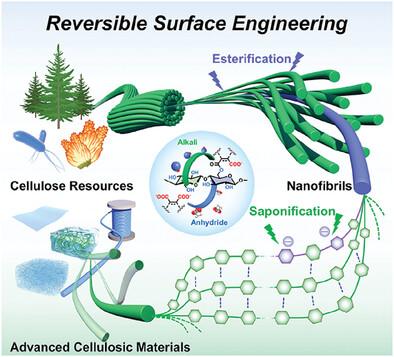当前位置:
X-MOL 学术
›
Adv. Mater.
›
论文详情
Our official English website, www.x-mol.net, welcomes your
feedback! (Note: you will need to create a separate account there.)
Reversible Surface Engineering of Cellulose Elementary Fibrils: From Ultralong Nanocelluloses to Advanced Cellulosic Materials
Advanced Materials ( IF 27.4 ) Pub Date : 2024-01-30 , DOI: 10.1002/adma.202312220 Meng Zhou 1 , Dongzhi Chen 2 , Qianqian Chen 1 , Pan Chen 3 , Guangjie Song 4 , Chunyu Chang 1
Advanced Materials ( IF 27.4 ) Pub Date : 2024-01-30 , DOI: 10.1002/adma.202312220 Meng Zhou 1 , Dongzhi Chen 2 , Qianqian Chen 1 , Pan Chen 3 , Guangjie Song 4 , Chunyu Chang 1
Affiliation

|
Cellulose nanofibrils (CNFs) are supramolecular assemblies of cellulose chains that provide outstanding mechanical support and structural functions for cellulosic organisms. However, traditional chemical pretreatments and mechanical defibrillation of natural cellulose produce irreversible surface functionalization and adverse effects of morphology of the CNFs, respectively, which limit the utilization of CNFs in nanoassembly and surface functionalization. Herein, this work presents a facile and energetically efficient surface engineering strategy to completely exfoliate cellulose elementary fibrils from various bioresources, which provides CNFs with ultrahigh aspect ratios (≈1400) and reversible surface. During the mild process of swelling and esterification, the crystallinity and the morphology of the elementary fibrils are retained, resulting in high yields (98%) with low energy consumption (12.4 kJ g−1). In particular, on the CNF surface, the surface hydroxyl groups are restored by removal of the carboxyl moieties via saponification, which offers a significant opportunity for reconstitution of stronger hydrogen bonding interfaces. Therefore, the resultant CNFs can be used as sustainable building blocks for construction of multidimensional advanced cellulosic materials, e.g., 1D filaments, 2D films, and 3D aerogels. The proposed surface engineering strategy provides a new platform for fully utilizing the characteristics of the cellulose elementary fibrils in the development of high-performance cellulosic materials.
中文翻译:

纤维素基本原纤维的可逆表面工程:从超长纳米纤维素到先进纤维素材料
纤维素纳米原纤维(CNF)是纤维素链的超分子组装体,可为纤维素生物体提供出色的机械支撑和结构功能。然而,天然纤维素的传统化学预处理和机械除纤分别产生不可逆的表面功能化和CNF形态的不利影响,这限制了CNF在纳米组装和表面功能化中的应用。在此,这项工作提出了一种简便且高效的表面工程策略,可以从各种生物资源中完全剥离纤维素基本原纤维,从而为 CNF 提供超高的纵横比(约 1400)和可逆表面。在温和的溶胀和酯化过程中,基本原纤维的结晶度和形态得以保留,从而实现高产率(98%)和低能耗(12.4 kJ g -1 )。特别是,在 CNF 表面上,通过皂化去除羧基部分来恢复表面羟基,这为重建更强的氢键界面提供了重要的机会。因此,所得的 CNF 可用作构建多维先进纤维素材料(例如 1D 长丝、2D 薄膜和 3D 气凝胶)的可持续构建模块。所提出的表面工程策略为在高性能纤维素材料的开发中充分利用纤维素基本原纤维的特性提供了新的平台。
更新日期:2024-01-30
中文翻译:

纤维素基本原纤维的可逆表面工程:从超长纳米纤维素到先进纤维素材料
纤维素纳米原纤维(CNF)是纤维素链的超分子组装体,可为纤维素生物体提供出色的机械支撑和结构功能。然而,天然纤维素的传统化学预处理和机械除纤分别产生不可逆的表面功能化和CNF形态的不利影响,这限制了CNF在纳米组装和表面功能化中的应用。在此,这项工作提出了一种简便且高效的表面工程策略,可以从各种生物资源中完全剥离纤维素基本原纤维,从而为 CNF 提供超高的纵横比(约 1400)和可逆表面。在温和的溶胀和酯化过程中,基本原纤维的结晶度和形态得以保留,从而实现高产率(98%)和低能耗(12.4 kJ g -1 )。特别是,在 CNF 表面上,通过皂化去除羧基部分来恢复表面羟基,这为重建更强的氢键界面提供了重要的机会。因此,所得的 CNF 可用作构建多维先进纤维素材料(例如 1D 长丝、2D 薄膜和 3D 气凝胶)的可持续构建模块。所提出的表面工程策略为在高性能纤维素材料的开发中充分利用纤维素基本原纤维的特性提供了新的平台。

































 京公网安备 11010802027423号
京公网安备 11010802027423号